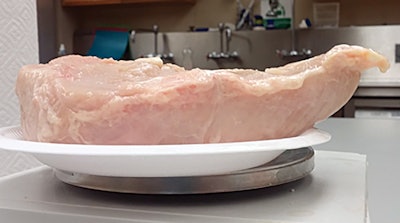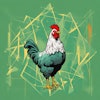
In recent years, an economically important muscle condition affecting the breast muscle of broiler chickens, usually called wooden or woody breast, has emerged in the broiler industry. New research helps shed light on its causes and potential solutions
This disorder is characterized by hard, chewy areas in the breast meat. Affected breast meat is safe to eat but usually unsuitable to be used as breast fillets. Little is known about the cause of the condition, but research has provided important new insight on this condition.
Origins of the condition
Two completed projects characterized the condition and provided information on how it develops in breast tissue.
The initial indication of a problem is seen as microscopic inflammation of the small veins in the breast muscle of two-week-old birds. Inflammation impairs blood flow and causes microscopic muscle fibers to die. These muscle fibers are replaced by microscopic scar tissue, which ultimately causes the muscle tissue to become “woody”. The longer the broiler lives, the longer this condition progresses.
Initially, it was presumed this condition occurred only in modern fast-growing broilers, but this research showed that the condition exists in a broiler genetic line from the 1950s, too. The condition simply does not progress far enough in the 1950s chickens to be noticeable.
Detection of woody breast
To identify affected breast fillets and remove them from the product line, each fillet must be manually inspected to determine its condition. This involves a great deal of tedious labor.
Some recent projects attempted to find methods to mechanize this inspection and sorting process. Techniques were developed using imaging-based technologies to create a type of vision grading, whereby automated equipment views the breast fillets and identifies those affected by woody breast.
Another technique was developed utilizing a handheld device that can be touched to each breast fillet and determine its condition automatically. These new technologies are providing the basis for improved sorting of breast fillets in broiler processing plants.
Future research topics
Ongoing areas of research focuses on factors involved with the rearing of broilers to determine how management factors contribute to the development of woody breast.
Several projects have looked at nutritional aspects of feeding broilers, but no correlation with the incidence of woody breast has been found with individual ingredients or nutrients. Current research is focused on the effect of nutrition during the first days of the broiler’s life. Moreover, research is being conducted to determine the effect of broiler growth rate on woody breast development.
Primary broiler breeding companies are also working to reduce the occurrence of this condition in their broiler lines through selective breeding.
Continued support
The key to eliminating this condition from the modern production system is the thorough understanding of the condition and its cause. As the poultry industry has successfully done with so many other new diseases or conditions, new knowledge gained through research will be used to implement solutions.
Continued support of research in this area is a top priority for USPOULTRY and the USPOULTRY Foundation.

















